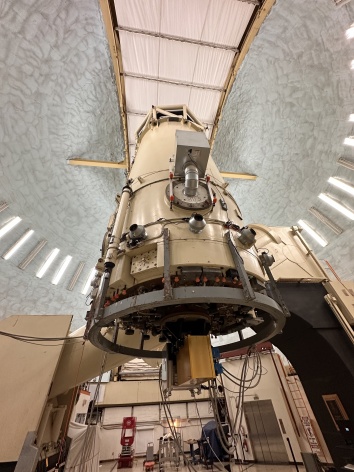
IGRINS installed on the Harlan J. Smith Telescope at McDonald Observatory. It is the yellow box mounted to the base of the telescope. Image credit: Erica Sawczynec, McDonald Observatory.
18 November 2024
BY EMILY HOWARD
After nearly a decade of globetrotting research, a powerful astronomical instrument has returned home to The University of Texas at Austin’s McDonald Observatory. The Immersion Grating Infrared Spectrograph (IGRINS) was re-installed on the Observatory’s Harlan J. Smith Telescope on October 17 and expects to start scientific operations on December 10.
“IGRINS is an incredible asset to McDonald Observatory and the greater astronomy community,” said Taft Armandroff, director of the Observatory. “Not only is it able to study objects that elude many other, similar instruments, it’s able to provide highly nuanced observations of them. We’re excited for its return and the research it will open to Texas scientists.”
Spectrographs are an essential tool for studying the universe. Similar to how prisms create a rainbow when sunlight passes through them, spectrographs split light apart into the many wavelengths of which it is composed. The result is a spectrum, which astronomers can analyze to learn about a celestial object’s chemical composition, temperature, motion through space, and more.
Though spectrographs are fairly common, IGRINS features an uncommon design. It pioneered the use what’s called an “immersion grating” to split infrared light into more individual wavelengths than would be possible with a traditional spectrograph. This allows IGRINS to be highly effective and relatively small. “It’s both a good and innovative instrument,” explained Kyle Kaplan, a McDonald Observatory research fellow who works on IGRINS. “A lot of new instruments use this technology now.”
IGRINS was first installed on McDonald Observatory’s Harlan J. Smith telescope in 2014. But it hasn’t stayed there. Thanks to its relatively small size – about that of a suitcase – IGRINS has travelled the world, helping other observatories in their research. From 2016 to 2019, IGRINS divided its time between the Harlan J. Smith Telescope and the Lowell Discovery Telescope in Arizona. From 2020 to 2024, it was at the Gemini South Telescope in Chile.
Each telescope has offered different advantages. Because they are very large, the telescopes at Lowell and Gemini provide powerful, zoomed-in views of the universe. This is great for studying faint points of light, like distant stars. Now that it’s back at McDonald Observatory, IGRINS will get a wider view of the cosmos. This is great for studying large-scale objects like massive jets of gas ejecting from stars and billowing clouds of gas and dust floating in space.
In addition, now that IGRINS is back at McDonald, astronomers will use it to learn about young stars, giant stars, and planets outside of our solar system. “We’re planning to use it simultaneously with the Habitable Zone Planet Finder and High Resolution Spectrograph on the Hobby-Eberly Telescope,” explained UT Austin’s vice president for research, Daniel Jaffe, who led the instrument’s design and construction. Using this suite of Observatory instruments will allow astronomers to view objects in a wide range of wavelengths, providing more depth and nuance to their research. “That should be very powerful.”
Not surprisingly, having IGRINS at McDonald Observatory translates to more access and convenience for astronomers there and at UT Austin. “It’s just easier to get time on the telescope,” explained Erica Sawczynec, a UT Austin graduate student who helped re-install IGRINS. “This means you can do things like observe a star multiple times a night, or multiple times a year, to see if there are any changes to its characteristics.” Many larger telescopes only view an object once due to time and financial constraints, leaving potentially important information undetected.
Greater accessibility also translates to more hands-on training for UT Austin astronomy students, who learn how to build, maintain, and use these scientific instruments. “One of the unique advantages of McDonald is it isn’t all buttoned up and sealed away,” explained Jaffe. “For students, it’s better to be able to go to the telescope, take your own data, and see how that’s done. That makes for better scientists.”
Over the last few months, scientists have upgraded some of IGRINS’s parts in their laboratory on the UT Austin campus. This will help ensure many more years of observations. Now that it’s back at McDonald Observatory, there are no plans for IGRINS to continue traveling. Instead, it will analyze the dark skies of West Texas, helping scientists answer persisting questions about our universe.
“McDonald and IGRINS are both very unique resources to Texas astronomy,” said Gregory Mace, a scientist who helped build and now helps maintain IGRINS. “Having the ability for students and researchers to use that for the next decade is sure to produce more amazing science.”
IGRINS was built by The University of Texas at Austin, UT’s McDonald Observatory, and the Korean Astronomy and Space Science Institute. Members of the public can see it on one of McDonald Observatory’s guided tours, which provide access to the Harlan J. Smith Telescope. These tours are offered daily, Tuesday through Saturday.

IGRINS installed on the Harlan J. Smith Telescope at McDonald Observatory. It is the yellow box mounted to the base of the telescope. Image credit: Erica Sawczynec, McDonald Observatory.